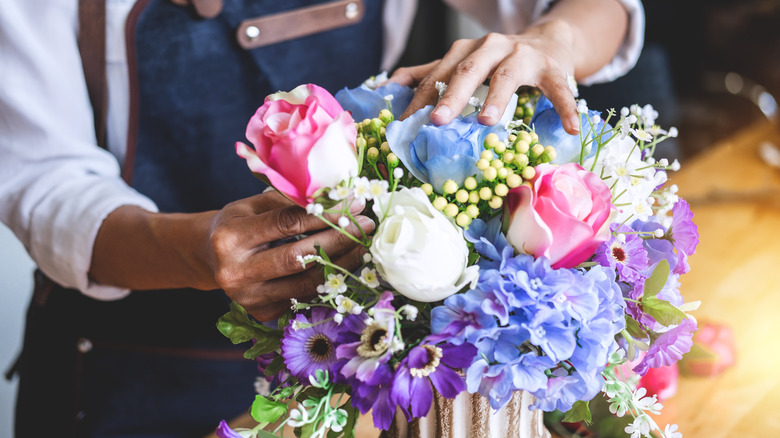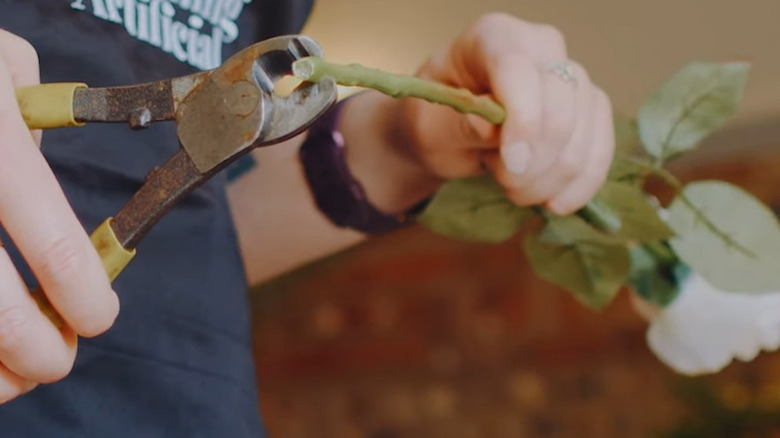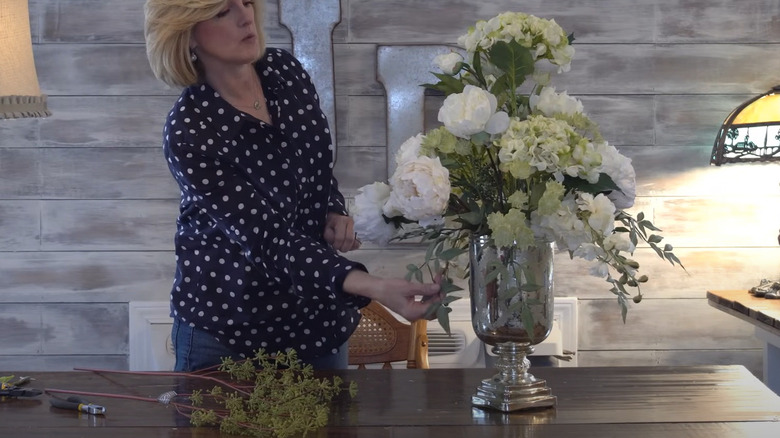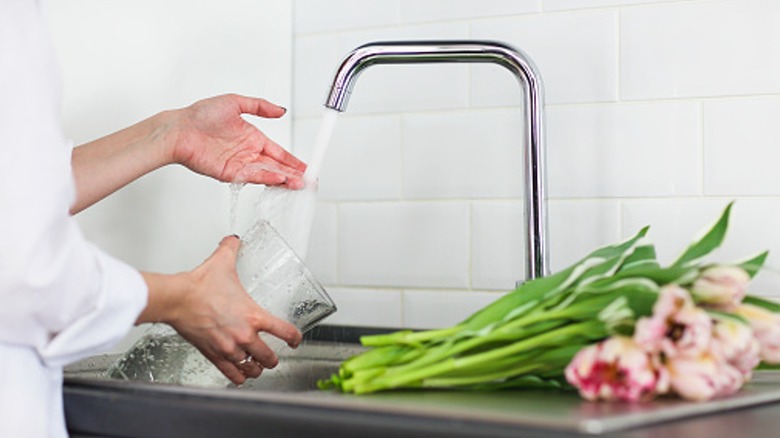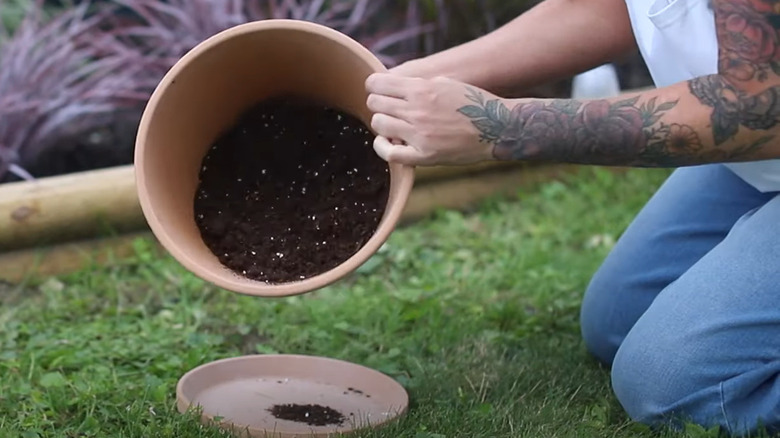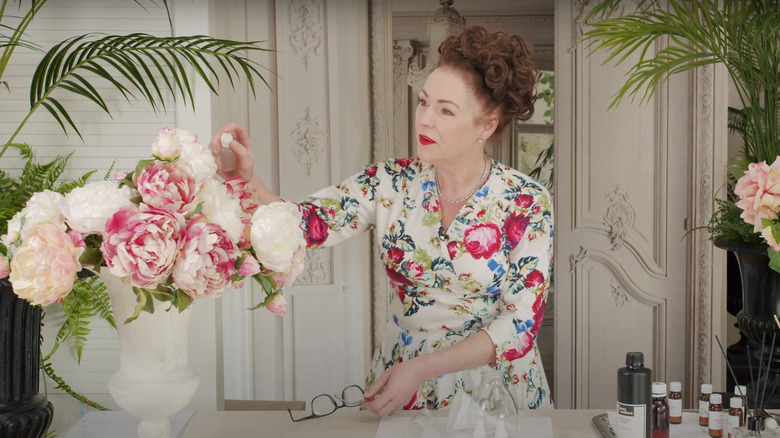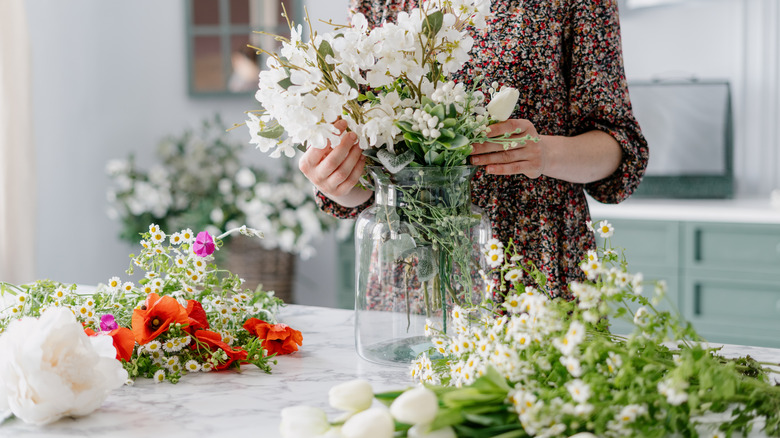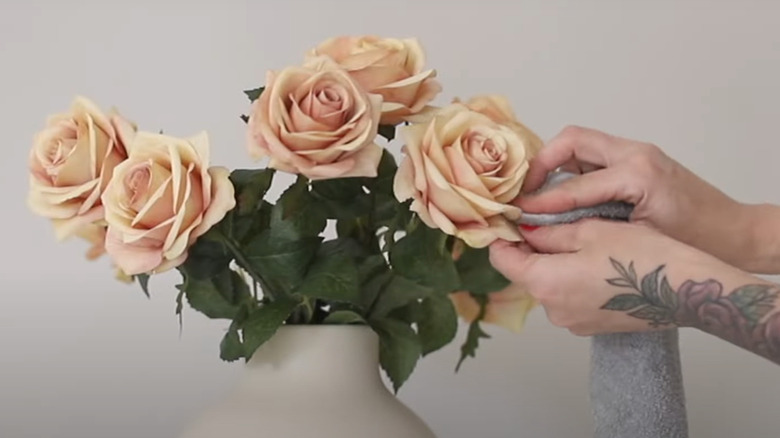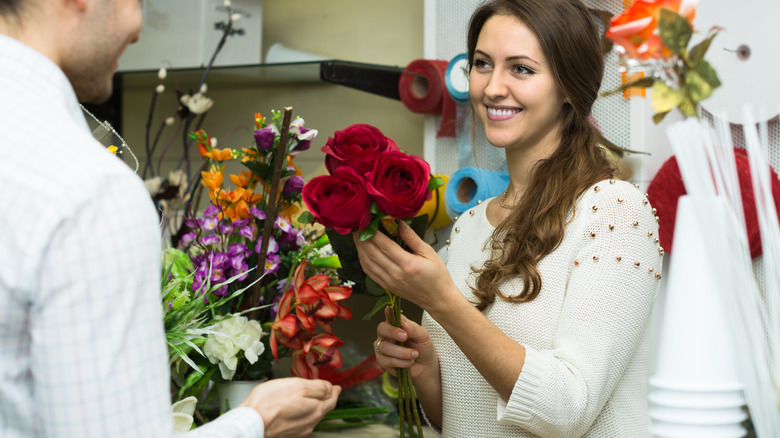Game-Changing Tricks That Make Artificial Flowers Look So Real
Who doesn't love receiving compliments on floral decorations around their home? But if the compliments you've been getting lately fall into the, "Oh, that fake flower arrangement looks so lovely" territory, it's time to up your approach and adopt a few game-changing tricks to make your artificial flowers look real. To illustrate, sneaking in a few real blooms and green foliage in with your faux ones will uplift the arrangement's aesthetic appeal and turn it life-like. Simply use real flowers that match the color and variety of your artificial ones for a designer-level look.
Another excellent trick is to fake it until other people believe it. Display your artificial blooms in spots you primarily reserve for fresh-cut ones. Don't take the easy way out and hide them in the bathroom, lower shelves, or behind other decor items. This means dining tables, balconies, living rooms, fireplace mantels, windowsills, and kitchens are all fair game. Sadly, your efforts will be for naught if you don't buy flowers that look real. For instance, if you're a fan of purple sunflowers, it's best to buy fakes that closely match the texture, shape, and coloring of Mother Nature's creation. But to do that, you must research the real flower's look and feel before you buy their faux counterparts. Additionally, steer clear of beads, glitter, and unnatural tones to perpetuate an au naturel look. With that said, here are a few more tricks to make your fake flowers seem real.
Invest in a gorgeous vase
Get a gorgeous flower vase for a cheerful arrangement of your artificial blooms. While spending money on a container might not seem fruitful, it's necessary to keep the ruse going. If you choose a cheap-looking vase, it will invite individuals to examine the flowers closely and nitpick their flaws. However, this doesn't mean you should buy an uber-expensive vase either. Simply raid thrift stores and estate sales to score striking, vintage, or rustic vases for the arrangement to engage an onlooker's curiosity and keep the heat of inspection off the flowers.
The first thing to consider when choosing a vase is the height of the flowers you intend to place inside it. The ideal vase will hit the stems just below the foliage, so measure the length accordingly. Regarding the shape — go with a vase with a narrow mouth, as it'll keep your fake flowers in place. Pick a round one if you want the flowers to spill over the edge. Alternatively, a box-shaped container works best for succulents. For the vase's color, pick something in a similar shade as the flowers or choose a contrasting tone. But ensure the shade goes with the overall room decor or it'll stick out like an eyesore. Another neat trick? Select an opaque vase if you don't intend to add water to your transparent vessels to hide the unsightly stems.
Fluff the flowers, straighten the leaves, and bend the stems
Your packaged artificial flowers might be a bit messy straight out of the box, but don't worry — you just need a couple of minutes to reshape the pressed flowers, creased leaves, and unnaturally straight stems before displaying them. Begin by fluffing the flowers and forcing open the crumpled petals (gently, of course). This should help them look life-like. If this doesn't work, grab your garment steamer to enhance the look of your faux flowers. Let the steamer heat up before moving the flower heads over its mouth to coax open the petals. Keep in mind that steaming works best on silk and foam flowers, but it might damage paper and plastic ones. Still, try steaming one flower (or petal) prior to subjecting the bunch to the heat.
Next, straighten the leaves. Rub them between your hands to straighten them and give them a few days to get their act together. But if you're pressed for time or the crease is incredibly stubborn, sandwich the leaf between a dry cloth, set your clothes iron (hair straightens work, too) on low heat, and carefully iron the foliage to get the creases out. As for the stems, give them a slight bend to help them mimic their natural counterparts. If you aren't sure about the bend's severity or angle, err on the side of caution and Google a picture of the actual flower for inspiration.
Snip the long stems of the flowers
Artificial flowers usually come with stems longer than necessary. Since you don't want them flopping over unflatteringly from the edge of the vase and undoing all your hard work, snip off the extra length to help them look real. Alas, the task isn't as simple as trimming a few inches using a sharp pair of scissors, though, mostly due to the metal wire core. Besides being difficult to cut, scissors can crumple the stem and leave you with an unclean cut, even if the stem is made of plastic. So, it's best to use dedicated tools like a wire or stem cutter. Pliers will also work in a bind.
To trim the wired stems, get your preferred tool, a vessel, and the long-stemmed flowers. Set yourself up in a room with ample light and ascertain the stems are clean. Once you're ready to go, quickly pop the flower inside the vessel to determine the length you'd like to snip off. Although you can guesstimate the length, it's best to use a pencil to be 100% sure. Now, use the cutter to snip off the unwanted length neatly; cutting along the notch might help. Exercise caution, as the cutters are quite sharp and might injure your hand if mishandled. Repeat this process for all the flowers until they fit the vase perfectly. Don't forget to clamp the tools shut before storing them away to avoid unwarranted accidents in the future.
Artfully arrange your faux flower arrangement
Once you have a gorgeous vase for your flowers and the blooms are all fluffed up, artfully arrange your selection to make them look authentic. Place some floral foam (or clay for large displays) at the bottom of the container to secure the arrangement. After you're done, attach the foam with hot glue, floral tape, or double-sided tape. But if you'll be housing the arrangement in varied containers, skip this step. In case you have a clear vessel, conceal the foam with dampened fake moss (or grass) to trick onlookers.
Now, place the biggest bloom in the center of the arrangement. You can adjust the stem's height per your preference. Once you're happy with your star of the show, add two more of the same flowers on either side to create a triangle. Just ensure they're slightly below it and there's some distance between the flowers. While you can use more flowers for a more extensive arrangement, stick to odd numbers for a striking finish.
Continue layering the same species or mix in complementary flowers that are a little smaller and shaped differently. For instance, pair hydrangeas with peonies to break up the monotonous texture, rather than mixing in peonies and roses, since both the blooms are circular. When you're nearly done adding flowers, use leaves and faux-seeded greenery to hide the bald spots and complete the arrangement. Drop a few petals on the surface underneath to stage the perfect "natural" flower arrangement.
Add water to the vase
What do you do when you buy (or are gifted) cut flowers? You hunt down a nice vase, fill it with water, and promptly put the flowers inside to keep cut flowers fresh for longer. So, why not practice the same with your artificial flowers? Though the flowers don't need hydration like their real counterparts, this simple trick will make them look real, especially if you're a fan of glass vases. All you have to do is fill the vase with 2 to 3 inches of water and pop the faux stems inside. Remember to switch the water every week or two to prevent discoloration.
However, this trick comes with a catch. Not all synthetic stems are fit for water. For instance, painted, paper, and plastic stems might dissolve in the liquid. Similarly, metal ones will develop rust. Expensive polyester and silk will bend out of shape or discolor. Worse, regular contact with water might dissolve the adhesive holding the stems, leaves, and flowers together. You might also have to deal with mold and mildew. Avoid the hassle by checking the flower's care label before dropping it in water.
Nevertheless, you don't have to ditch the water plan entirely. Simply substitute tap water with acrylic water. You can order 8 ounces of Gray Lane's acrylic water for under $22 from Amazon. Once you have it, follow the manufacturer's instructions to achieve the desired look. Ensure you're happy with the arrangement before the solution hardens.
Plant the flowers in soil to hide their faux stems
Another great way to hide stems and stage your faux blooms as authentic is to plant them in soil. Besides tricking onlookers, this simple hack will weigh down the flowers and keep them from toppling over in unfavorable weather conditions. The best part, though? The staging is incredibly simple, as you won't have to worry about soil type, health, or drainage to simulate a real arrangement. Always use dry soil, as moisture spells trouble for your faux flowers' stems. Additionally, check the soil for insects to prevent them from gorging and nesting on your flowers.
The easiest way to conceal the stems in the soil is to pour dirt inside the vessel, plant the flowers inside, and call it a day. If you're worried about the stability of the flowers or the soil solidifying into an unyielding block, fill ¼ to ½ of your vessel with soil. Then, fashion a chicken wire into a ball and stuff it inside your chosen vase. Once done, carefully push the flowers through the gaps in the wire. Complete the look with some soil on top. But, if this sounds like a lot of work, cover the container's base with dry soil (or sand), put the flowers inside, and cover the top with decorative rocks, beads, pebbles, or marbles. The soil will anchor the flowers, while the uneven stones will boost the arrangement's visual appeal and hide the artificial stems.
Make your artificial flowers smell real
You spent so much time covering your tracks, only to have a curious nose smell the lie of your fake arrangement. The good news is you can win on this front, too, by scenting the flowers. All you need to do is apply one to two drops of floral essential oil directly to the center of the flower to mask its superficial smell. Brownie points if you find the exact smell based on your artificial flower's type to satisfy curious noses.
However, don't be overzealous and soak the flower in the essential oil, or the unnaturally strong scent will give you away. Further, don't forget about the stems and the leaves. To scent the foliage, pour one to two drops of a matching essential oil into a cotton ball or pad and rub it gently on each leaf and stem. This method comes with a caveat: If you don't use an alcohol-free oil or if the oil is too heavy, direct contact will stain the flowers permanently and ruin them. So, if you'd rather not risk it, use a matching fragrant oil. Simply mix around half a teaspoon of your chosen fragrant oil with 1 ounce of water and pour the solution into a spray bottle. Now, liberally spray your floral arrangement with the prepared solution to scent them. Alternatively, placing an essential oil diffuser next to the floral arrangement will add a realistic fragrance to the fake blooms.
Display artificial flowers according to the season
Despite all your efforts, you'll be caught red-handed if you display blooming sunflowers in the dead of winter. Similar to how you put away your faux Christmas tree once the new year rolls around, it's important to keep up with seasonal changes and display faux flowers around your house accordingly. For instance, daffodil, tulip, crocus, hyacinth, forsythia, primrose, and azaleas are some flowers that bloom in the garden in early spring. Come summer, switch these flowers in favor of marigolds, hydrangeas, black-eyed Susans, sunflowers, roses, and moonflowers. When fall (or autumn) arrives, trade your bright summer flowers for chrysanthemums, petunias, canna lilies, pansies and violas. Cyclamen, ranunculus, winter jasmine, and hellebore will look authentic in winter.
When not in use, store your fake flowers in a cool, dry, and dark place. If possible, place the flowers in air-tight containers with lids to keep them dust-free. Otherwise, keep the stems standing and give the flowers and foliage space to avoid unnatural bends. But if this seems like a lot of work, not to mention the time and money you'll have to invest to curate seasonal arrangements, stick to flowers that bloom year-round, like African violets and lantana (if you experience tropical weather). If you go this route, move the arrangement around and display it in different locations to keep suspicion off your flowers. Don't forget about the foliage to avoid leaving twigs of holly spray nestled between your summer flowers.
Keep your fake arrangement spick and span
A thick layer of dirt and dust on your faux arrangement will reveal your secret and alert onlookers to their fakeness. When dealing with dusty latex blooms, a damp microfiber cloth is your best friend. Carefully clean each petal, stem, and foliage to remove the dirt. Once done, allow the flowers to dry. This method isn't suitable for silk and fabric varieties since contact with water might cause their colors to bleed. Under such circumstances, you can spring for a dedicated cleaning solution (FYI, they're expensive). Or, dump some coarse salt in a plastic bag (or big container), stick the dirty flowers inside, shake the bag, and let the abrasive kitchen ingredient make your old fake flowers look brand new.
Another method is to use a can of compressed air for flowers with plenty of creases, provided you maintain a distance of 6 to 8 inches from the floral arrangement. Move the flower arrangement out of your home (near a window is also fine) to prevent the blown-off dust from clinging to other areas. A blow-dryer on the low heat (or cool) setting will help you out in a bind. It's best to steer clear of water and chemical cleaners, since they might harm your flowers and dissolve the adhesive holding everything together. Make it a habit to dust them using a microfiber cloth once or twice a week, depending on the amount of dust they accumulate, to keep your flowers clean.
Choose good quality faux flowers
No trick in the book will save your faux flowers if you buy blooms that scream plastic. Follow Joanna Gaines' top tip to make artificial flowers look real and carefully inspect their material, petals, stems, and joints before bringing them home. Your top priority is choosing a material that closely resembles the real deal. As such, silk is your best bet. These flowers are the most expensive of the bunch, but the attention to detail and realism make them worth it. Cotton and polyester are other good fabric options. Contrastingly, if you want flowers that have the same feel as natural ones, go for latex. Made from the mold of real blooms, these real-touch flowers imitate their attributes to a T. Unfortunately, they're available in only three varieties — roses, orchids, and lilies — and are not suited for individuals with a latex allergy. Go with foam for the accent flowers in your arrangement.
Moreover, the center of the flowers should have the same texture and detail as their organic cousin. As for the stems, they should be a natural green, not bluish-green, and have wire at the core so you can adjust their height easily. The petals should be soft, their edges shouldn't be worn, and the veins should look realistic. Similarly, the leaves should be detailed. Finally, observe if all the individual components go together. Ensure there's no big blob of glue ruining the ruse, and the calyx has the same tone as the stem.
